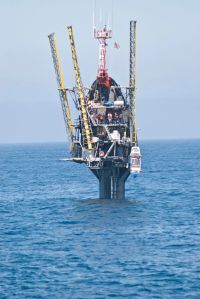 After 61 years of service, the one of its kind research vessel FLoating Instrument Platform, known as FLIP, has been retired and sent to a scrapyard. I distinctly recall being absolutely fascinated by this engineering marvel when it was almost brand new. As not quite a teenager, I remember being taken by both the simplicity and wonderful weirdness of the 355-foot-long research platform with a generally ship-shaped bow and a largely cylindrical hull.
After 61 years of service, the one of its kind research vessel FLoating Instrument Platform, known as FLIP, has been retired and sent to a scrapyard. I distinctly recall being absolutely fascinated by this engineering marvel when it was almost brand new. As not quite a teenager, I remember being taken by both the simplicity and wonderful weirdness of the 355-foot-long research platform with a generally ship-shaped bow and a largely cylindrical hull.
The vessel would be towed to deep water, where the ballast tanks in the stern would be filled with seawater and the craft would literally “flip” from horizontal to vertical. With 300 feet of the hull floating upright underwater, the research platform would float serenely in deep water, literally unmoved by ocean swells. (If this description doesn’t make any sense to you, check out the video below of the FLIP flipping.”
Launched on June 22, 1962, FLIP was the brainchild of two Scripps Institution of Oceanography scientists, Fred Fisher, and Fred Spiess, as an exceptionally stable platform for research related to a U.S. Navy submarine weapons program. Over its long career, FLIP was owned by the U.S. Office of Naval Research (ONR) and operated by Scripps.
The design is essentially a massive 355-foot-long spar buoy with ballast tanks and space for research equipment and instrumentation, as well as accommodation spaces for scientists and engineers.
FLIP was used to study oceanic wave height, acoustic signals, water temperature and density, and for the collection of meteorological data. Because of the potential interference with the acoustic instruments, FLIP had no means of propulsion. It was towed to open water, where it drifted freely or was anchored.
FLIP was 700 gross tons and carried a crew of five, plus up to eleven scientists. It was capable of operating independently during month-long missions without resupply. It could be operated around the world, although it normally operated off the West Coast of the United States from a home base at Scripps’ Nimitz Marine Facility in San Diego, California.
The ship had specially designed interiors: some fixtures, such as the toilet seats, could flip 90°, and the shower heads are curved 90°. There were overhead lights on the surfaces that are the ceilings in both the towing (horizontal) and flipped orientations.

Rick, what a too-quiet end to the distinguished career of of an amazing vessel. I remember seeing the news of her launch and what folks hoped to accomplish with her; it was one of those things that filled me with awe, hoping that this strange ship could help answer questions about our maritime environment. It’s worth a song, for sure — if you could, would you send me links I could use to craft a song around?
I finally came back to the Shanty Session at the Noble Maritime Collection this afternoon after shoulder replacement surgery and months of rehab. It was great to be back in the Great Hall, with friends all around, and singing the old (and the newer) songs together. The legends didn’t simply die with wood planking and hemp — much can still be celebrated. Like I said, if you can feed me some links about FLIP, I’d love to try my hand at memorializing her.
Incredible what you can do with a set logarithms, slide rules, pencils and paper.
The cost of just designing her today by computer and the mountain of rules and regulations would be a serious hurdle to overcome let alone the cost.
And can you imagine modern management’s reaction to “And by the way, the crew will be crawling over the bow when she flips.”
I remember being inspired by this marvel as a child and wanting to do a trip aboard. Like Concorde and the QE2, that opportunity has vanished forever.
I do hope Jan and others can keep the memory of this astounding vessel alive. The section that remains proud of the water would make an amazing and popular static display that would inspire future generations.
Pingback: Inspired by FLIP, Polar Pod to Explore the Mysteries of the Southern Ocean - Walrus Neat